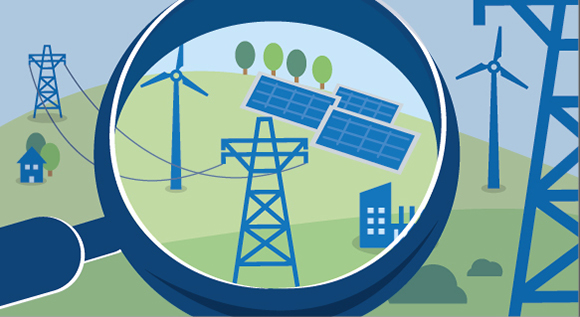What is a ‘Grid Development Plan’?
Up to 16 October, citizens in Germany have the opportunity to set out their comments about the current grid development plans. But what do the plans actually set out themselves? Read on to find out more.
 © BMWi
© BMWiIt’s all about making the electricity grid fit for the demands of the future
Some people produce electricity, other people use it. Although this sounds pretty simple, a lot of detailed planning is required to make things work in practice. Our electricity is being generated from ever greater shares of renewable energy. This makes it essential for us to plan and adapt our electricity system in a far-sighted way so that consumers continue to receive a secure supply of electricity and the grid does not exceed its upper capacity limits. More and more of our electricity is being produced from wind energy in the north and east of Germany, while the large, industrial consumers are located in the south and west. We therefore need to expand our transmission grid. This is why the four largest grid operators 50Hertz, Amprion, TenneT and TransnetBW have created Grid Development Plans mapping out exactly where they think the present legislation for new power lines or for the expansion of existing ones does not go far enough, and additional action is needed.
Forecasts for up to 2035
Germany has one Grid Development Plan for its electricity grid onshore, and another that sets out the work that needs to be undertaken to connect offshore wind power installations in the North and the Baltic Seas up to the grid. In both cases, network operators describe the measures that they think are needed to adapt, expand and modernise the grid in order to ensure that Germany’s electricity supply remains secure. These plans currently run up to 2035. The grid operators develop their Grid Development Plans based on what is set out in the Energy Industry Act. But how are they able to plan so far into the future?
Grid development plans based on supply-and-demand scenarios and market models
The supply-and-demand scenarios that form the basis of the Grid Development Plans bring together forecasts for electricity generation and those for future consumption. They set out the volumes of electricity that will most likely have to be transported across the German grid, going forward. The grid operators use these data projections to simulate the future electricity market. This involves breaking down projected figures into the different regions in order to identify how much capacity each crosspoint has available when electricity from all sources of energy – both conventional power plants and renewables-based installations – is flowing through the grid. Another model is then used to calculate how much electricity will be exchanged between the different regions. This allows the ‘transmission requirements’ to be determined – in other words, how much electricity the grid needs to be able to transport during peak periods. With these projected figures on hand, the transmission system operators (TSOs) then look at the existing grid infrastructure and the expansion work that is planned. Will this work be enough or must Germany take further action beyond this? The response of the TSOs to this question is then set out in the Grid Development Plans.
Opportunities for the general public to have their say
At the start of the year, the transmission system operators invited the public to submit their comments on the first drafts of the Grid Development Plans. More than 2,000 people and organisations responded. The revised proposals were passed on to the Bundesnetzagentur (Federal Network Agency) in May, which is responsible for assessing the plans. According to the current status of the assessments, the Bundesnetzagentur considers 90 of the 160 measures proposed by the transmission system operators in the current version of the Grid Development Plan to be necessary. A total of 70 measures are classified ‘unable to be approved’ at present.

